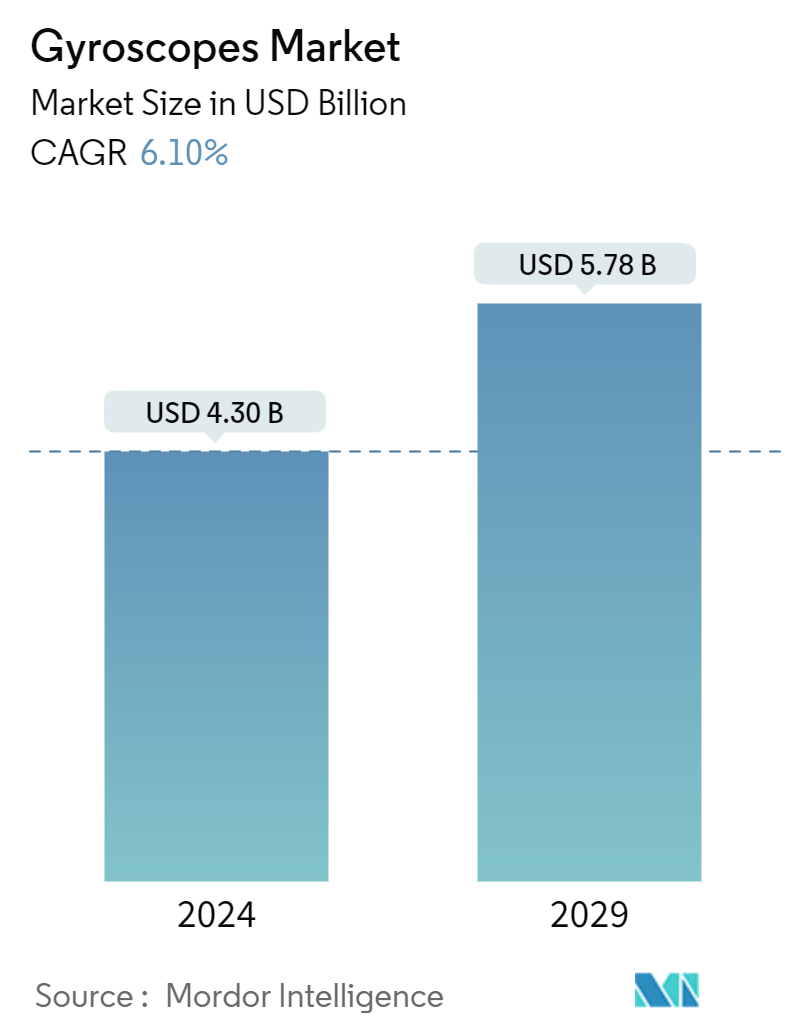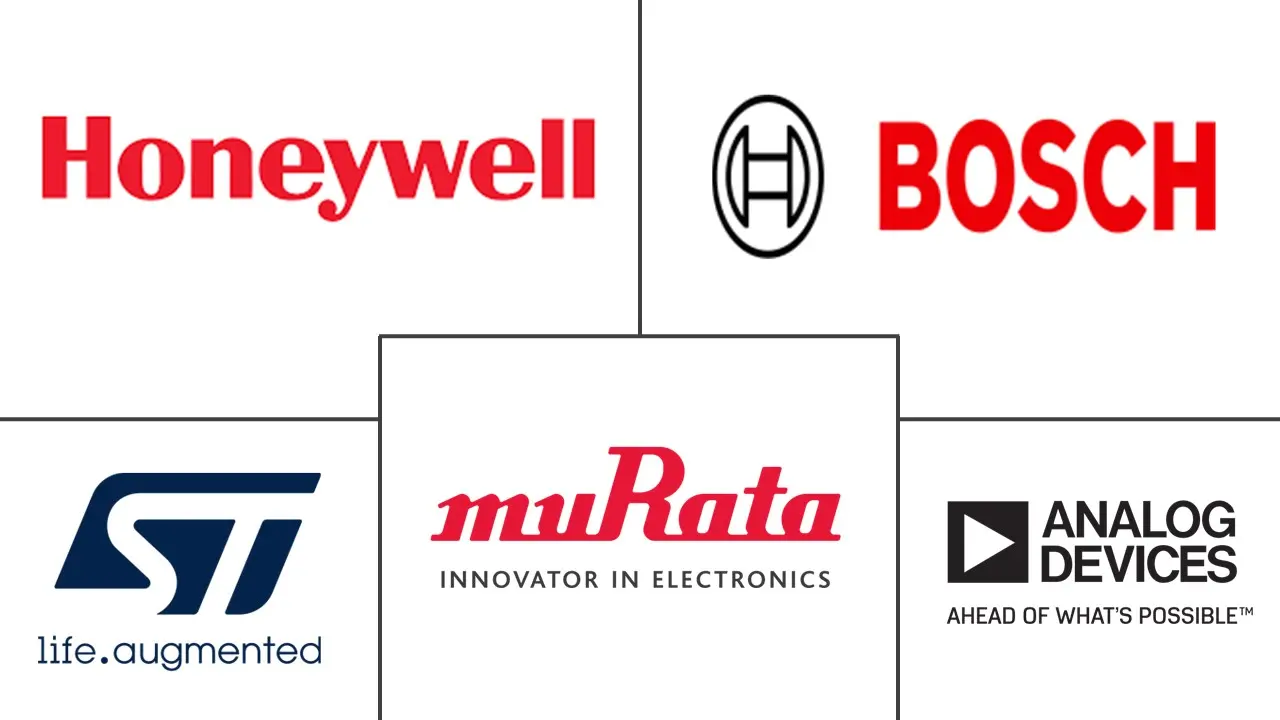Market Size of Gyroscopes Industry

| Study Period | 2019 - 2029 |
| Market Size (2024) | USD 4.30 Billion |
| Market Size (2029) | USD 5.78 Billion |
| CAGR (2024 - 2029) | 6.10 % |
| Fastest Growing Market | Asia Pacific |
| Largest Market | Asia Pacific |
| Market Concentration | Low |
Major Players
*Disclaimer: Major Players sorted in no particular order |
Gyroscope Market Analysis
The Gyroscopes Market size is estimated at USD 4.30 billion in 2024, and is expected to reach USD 5.78 billion by 2029, growing at a CAGR of 6.10% during the forecast period (2024-2029).
Gyroscope technology has witnessed many innovations in the past decade with the introduction of MEMS-based gyroscopes. The accuracy and efficiency of the gyroscopes have also improved, as multi-axis gyroscopes are more accurate due to digital integration. The applications of gyroscopes have also expanded over the past few years, with the consumer electronics and industrial segments finding significant implications for the technology.
- The rapidly growing adoption of drones and unmanned aerial vehicles (UAVs) in the defense and commercial sectors has been expected to be a significant driver in the market. An Unmanned Aerial Vehicle (UAV) is an airborne system or an aircraft operated remotely by a human operator or autonomously by an onboard computer for warfare and surveillance. Due to the increase in research and development, the adoption rate of UAVs is rising.
- According to National Defense, a business technology magazine, the cost of research, development, and procurement for UAVs is expected to increase from USD 11.1 billion in 2020 to USD 14.3 billion by 2029. Additionally, it is anticipated that R&D spending will increase from USD 3.2 billion in 2020 to USD 4 billion in 2029. Procurement funding will rise from USD 7.9 billion in 2020 to approximately USD 10.3 billion by the decade's end. The market is expanding due to the increasing use of drones and UAVs.
- Further, industrial automation and demand for miniaturized consumer devices, such as wearables and IoT-connected devices, among others, across regions are among the significant factors driving the MEMS Gyroscope demand in the studied market.
- However, high initial costs and operational concerns are the major factors anticipated to restrain the growth of the studied market over the forecast period. Further, as an essential part of producing superior sensors, high-quality raw materials are vital for manufacturers. Metals and alloys used in manufacturing include Platinum, Copper, Silicon, Tungsten, and Nickel, and alloys, which are further categorized into type-K, type-M, type-E, type-J, and so on. Fluctuations in prices and supply of raw materials could also cause hindrances in the growth of the studied market.
Gyroscope Industry Segmentation
Gyroscopes are defined as sensors that are used for the measurement of orientation in multiple devices. Since their inception, gyroscopes have evolved considerably, primarily aided by incremental technological innovations. This has helped them emerge as one of the most integral components in any navigation system.
The gyroscopes market is segmented by technology (MEMS gyroscope, fiber optic gyroscope (FOG), ring laser gyroscope (RLG), hemispherical resonator Gyroscope (HRG), dynamically tuned gyroscope (DTG), and other technologies), by end-user vertical (consumer electronics, automotive, aerospace, and defense, industrial, marine, and other end-user verticals), and by geography (North America [United States, Canada], Europe [Germany, United Kingdom, France, Rest of Europe], Asia Pacific [China, Japan, India, Rest of Asia Pacific], rest of the World). The report offers market forecasts and size in value (USD) for all the above segments.
| By Technology | |
| MEMS Gyroscope | |
| Fiber Optic Gyroscope (FOG) | |
| Ring Laser Gyroscope (RLG) | |
| Hemispherical Resonating Gyroscope (HRG) | |
| Dynamically Tuned Gyroscopes (DTG) | |
| Other Technologies |
| By End-user Vertical | |
| Consumer Electronics | |
| Automotive | |
| Aerospace and Defense | |
| Industrial | |
| Marine | |
| Other End-user Verticals |
| By Geography | |||||
| |||||
| |||||
| |||||
| Australia and New Zealand | |||||
| Latin America | |||||
| Middle East and Africa |
Gyroscopes Market Size Summary
The gyroscope market is poised for significant growth, driven by advancements in technology and expanding applications across various sectors. The introduction of MEMS-based gyroscopes has enhanced accuracy and efficiency, particularly in multi-axis systems due to digital integration. This technological evolution has broadened the scope of gyroscopes, with notable applications in consumer electronics and industrial sectors. The increasing adoption of drones and unmanned aerial vehicles in defense and commercial industries is a major catalyst for market expansion. Additionally, the demand for miniaturized consumer devices, such as wearables and IoT-connected gadgets, is further propelling the need for MEMS gyroscopes. However, challenges such as high initial costs, operational concerns, and fluctuations in raw material prices pose potential restraints to market growth.
In the automotive industry, gyroscopes play a crucial role in enhancing vehicle safety and performance through applications in advanced driver assistance systems (ADAS), stability control, and navigation systems. The rising production of passenger vehicles and the growing integration of autonomous driving technologies are key factors driving the demand for gyroscopes in this sector. The market is also witnessing increased traction in regions like China, Japan, and India, fueled by the burgeoning consumer electronics market and the rapid expansion of 5G technology. The presence of major industry players and ongoing technological advancements, such as the development of AI-enabled inertial measurement units, are contributing to the competitive landscape of the gyroscope market. These developments underscore the market's potential for sustained growth and innovation in the coming years.
Gyroscopes Market Size - Table of Contents
-
1. MARKET INSIGHTS
-
1.1 Market Overview
-
1.2 Industry Attractiveness - Porter's Five Forces Analysis
-
1.2.1 Threat of New Entrants
-
1.2.2 Bargaining Power of Buyers/Consumers
-
1.2.3 Bargaining Power of Suppliers
-
1.2.4 Threat of Substitute Products
-
1.2.5 Intensity of Competitive Rivalry
-
-
1.3 Industry Value Chain Analysis
-
1.4 Impact of Macro Economic trends on the Industry
-
-
2. MARKET SEGMENTATION
-
2.1 By Technology
-
2.1.1 MEMS Gyroscope
-
2.1.2 Fiber Optic Gyroscope (FOG)
-
2.1.3 Ring Laser Gyroscope (RLG)
-
2.1.4 Hemispherical Resonating Gyroscope (HRG)
-
2.1.5 Dynamically Tuned Gyroscopes (DTG)
-
2.1.6 Other Technologies
-
-
2.2 By End-user Vertical
-
2.2.1 Consumer Electronics
-
2.2.2 Automotive
-
2.2.3 Aerospace and Defense
-
2.2.4 Industrial
-
2.2.5 Marine
-
2.2.6 Other End-user Verticals
-
-
2.3 By Geography
-
2.3.1 North America
-
2.3.1.1 United States
-
2.3.1.2 Canada
-
-
2.3.2 Europe
-
2.3.2.1 Germany
-
2.3.2.2 United Kingdom
-
2.3.2.3 France
-
-
2.3.3 Asia
-
2.3.3.1 China
-
2.3.3.2 Japan
-
2.3.3.3 India
-
-
2.3.4 Australia and New Zealand
-
2.3.5 Latin America
-
2.3.6 Middle East and Africa
-
-
Gyroscopes Market Size FAQs
How big is the Gyroscopes Market?
The Gyroscopes Market size is expected to reach USD 4.30 billion in 2024 and grow at a CAGR of 6.10% to reach USD 5.78 billion by 2029.
What is the current Gyroscopes Market size?
In 2024, the Gyroscopes Market size is expected to reach USD 4.30 billion.

